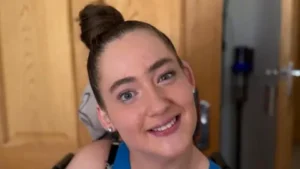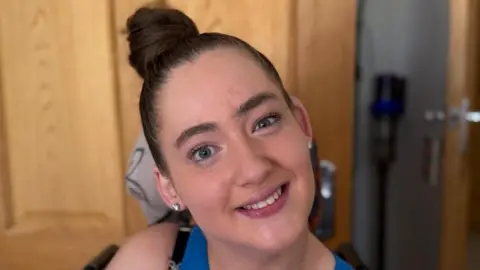In a troubling incident in the world of social media, TikTok creator Grace Wolstenholme has brought awareness to the dangers of disinformation on platforms like TikTok after a video falsely claiming she had died was watched by over 650,000 users. The 22-year-old from Essex, who has garnered a following of 1.3 million since she started posting videos about her life with cerebral palsy, gained notoriety for her unique content that blends humor and advocacy.
Wolstenholme’s original viral video, which accumulated 5.2 million likes, depicted her comedic yet sincere experience working with personal trainers in a gym setting. However, this authentic content was misappropriated without her consent by another TikTok account, which advertised pillows while claiming, “I lost my autistic sister today so I bought this pillow to imitate cuddling her.” This blatant misuse prompted Wolstenholme’s immediate concern when she was informed by friends who had mistakenly believed the death hoax to be true and sent their condolences.
TikTok took action against the misleading video after Wolstenholme reported it, stating that it violated their community guidelines. Despite this, the ongoing efforts by BBC reporters to establish contact with the anonymous user who spread the falsehood have been in vain, further emphasizing the challenges of accountability in the social media landscape.
In her own words, Grace expressed the need for caution amongst social media users, stating, “There’s a lot of bad people on social media, so you do need to check the facts.” This statement underlines the ongoing struggle against misinformation, particularly when the stakes are high, such as in cases of death or injury. Wolstenholme has had to confront the emotional weight of the situation, confronting anxiety triggered by the distress that fans expressed regarding her supposed demise.
This incident left her reeling, as she reported a hurtful decline in her follower count, attributing this loss to people’s misguided belief that she had passed away. The impact of the false narrative on her view and engagement numbers has adversely affected her income, given that TikTok compensates creators based on their content’s performance.
The viral nature of the hoax was exacerbated by Wolstenholme being somewhat inactive due to health issues, which led many to genuinely believe she was no longer alive. Comment sections filled with sentiments like “rest in peace, Grace. I love you” made it evident how widespread the misconception had become. Wolstenholme expressed her frustration regarding how the situation escalated, highlighting the misinformation about her disability, stating, “My disability isn’t autism; it’s cerebral palsy.”
Despite the removal of the initial offending video, it resurfaced, further perpetuating the narrative fabricated by the original poster. Wolstenholme, facing relentless harassment from the user, sought help and reported the situation to the Metropolitan Police, which confirmed they were looking into the matter but had not yet made any arrests.
This distressing scenario highlights the detrimental effects of unchecked misinformation and harassment on social media platforms. Wolstenholme urged not just her followers but a broader audience to remain vigilant against disinformation while emphasizing the mental health implications that such fabricated narratives can have on individuals and communities.
Through her experience, Grace Wolstenholme has become an outspoken advocate for more mindful engagement with social media, reflecting on how easily misinformation can gain traction and impact real lives. As calls for stricter regulations and accountability grow, her situation serves as a powerful reminder of the urgency needed to address disinformation online.











